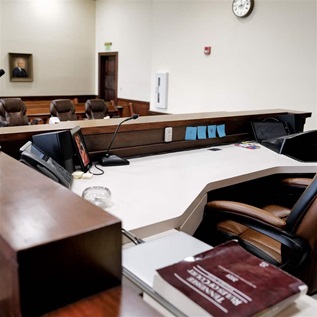Second In Series Of Calder Sculpture Placed On Ben Franklin Parkway
Thanks to a very generous $5 million grant to the Philadelphia Museum of Art from the Pew Charitable Trusts in 2001, the Benjamin Franklin Parkway today became the site for the second in an on-going series of displays of artistic treasures that will augment the enjoyment of any stroll along the parkway for the next year. The constellation of 11 outdoor sculptures by the Philadelphia-born sculptor Alexander Calder (1898-1976)—one of the great artists of the 20th century—is situated at 22nd Street and the Parkway, on the site of the proposed Calder Museum.
The much-anticipated installation brings to Philadelphia eight new loans from the Calder Foundation that range over the two decades during which the artist was most engaged in the creation of outdoor sculptures on a monumental scale. They include Funghi Neri (1957); Discontinuous (1962); Polygons on Triangles (1963); The Rocket (1964); Dent de Sagesse (Wisdom Tooth) (1964); The Tall One (1968); Untitled (1972); and Angulaire (1975). All are constructed of sheet metal, painted black. This group of elegant sculptures now gracefully interacts with Ordinary (1969), the 21-foot tall, multi-colored stabile/mobile that had already occupied the site, and with two other painted, metal stabiles that formerly were seen in the garden of the Rodin Museum, including The Pagoda (1963), also lent by the Calder Family Foundation, and Three Discs, One Lacking (1968), owned by the City of Philadelphia. With the installation of Calder's works along the Parkway, Philadelphians and visitors alike can fully appreciate the boldness and brilliance of Calder's art as they approach the area where the new museum is expected to rise.
The 12-year program funded by The Pew Charitable Trusts underscores the connection of Calder's work to the achievements of his father, Alexander Stirling Calder (1870–1945) who designed the Swann Memorial Fountain (1924) at Logan Circle, and his grandfather, Alexander Milne Calder (1846-1923), who designed the gigantic figure of William Penn that stands atop the clock tower of City Hall (1886-1894), as well as all the other bronze and marble sculptures which embellish that great building.
Anne d'Harnoncourt, Director and Chief Executive Officer of the Philadelphia Museum of Art, said: "Philadelphia is the quintessential sculptor's city, with superb sites for a wealth of public art executed over the past three centuries. Nowhere is this more evident than in the succession of sculptures by three generations of Calders along the Parkway, now so brilliantly enriched. We are delighted to work with the Pew Charitable Trusts, the Calder Foundation and the Fairmount Park Commission to bring these spectacular works to Philadelphia."
Alexander S. C. Rower, Director of the Calder Foundation, said: “I can think of no more appropriate place to celebrate the greatness of my grandfather's work. It is extraordinary in this urban garden and underscores the remarkable place that generations of my family hold in the city of Philadelphia.”
"The Pew Charitable Trusts is proud to support this magnificent display of sculptures by Philadelphia's own Alexander Calder," said Rebecca Rimel, president and CEO of The Pew Charitable Trusts. "What a wonderful contribution these works provide to a renewed Benjamin Franklin Parkway, for the benefit of our residents and an ever-growing number of visitors."
The installation was coordinated on behalf of the Philadelphia Museum of Art by Jessica Senker of S. Harris and Co., with landscape architectural consultation by the Olin Partnership.
Alexander Calder was the third generation of the accomplished artistic family from Philadelphia. Alexander Milne Calder, who immigrated to Philadelphia from Scotland, created some 200 sculptural decorations adorning City Hall in addition to the much-loved bronze statue of William Penn. Alexander Stirling Calder, who was born in Philadelphia was especially noted for his Swann Memorial Fountain but also created many other sculptures throughout the city and on the Parkway. At the western end of the Parkway, Alexander Calder's ethereal mobile Ghost (1964) is suspended in the great stair hall of the Philadelphia Museum of Art. Members of Calder's family formed the Calder Foundation in 1987 to promote, research and disseminate Alexander Calder's work.
Alexander Calder was born in Lawnton, Pennsylvania, in 1898. He graduated in 1919 from the Stevens Institute of Technology with a degree in mechanical engineering. In 1923, after a series of assorted jobs, he entered the Art Students League in New York and embarked on a career that would revolutionize the course of modern sculpture and earn him international renown. From 1926 to 1929, his miniature wire circus sculpture and performance piece, Cirque, brought Calder to the attention of the art world's leading figures, including Miró, Leger, Mondrian, and Picasso. He worked in a wide range of media and is best known for inventing freely moving constructions suspended in air (for which Marcel Duchamp coined the term “mobiles”) and for his large freestanding sculptures (dubbed “stabiles” by Jean Arp). In the final decades before his death in 1976, he devoted himself increasingly to monumental outdoor sculpture. His work figures prominently in the modern collections of major museums throughout the world. A retrospective exhibition celebrating the centennial of his birth at the National Gallery of Art, Washington, D.C., in 1998, also shown at the San Francisco Museum of Modern Art, attracted 603,700 visitors during its run in the two cities.











